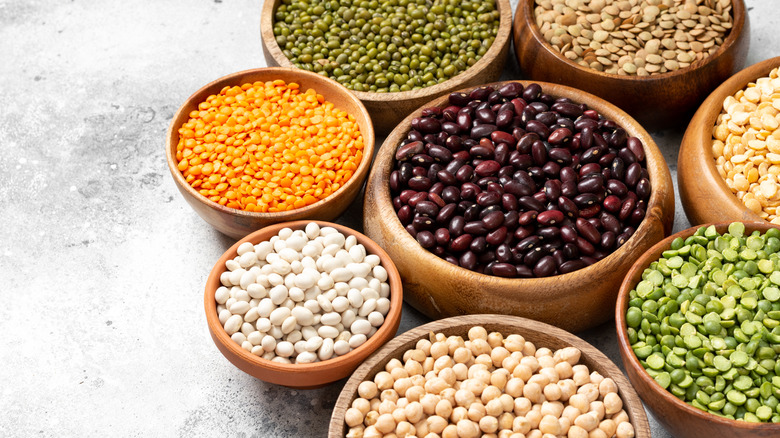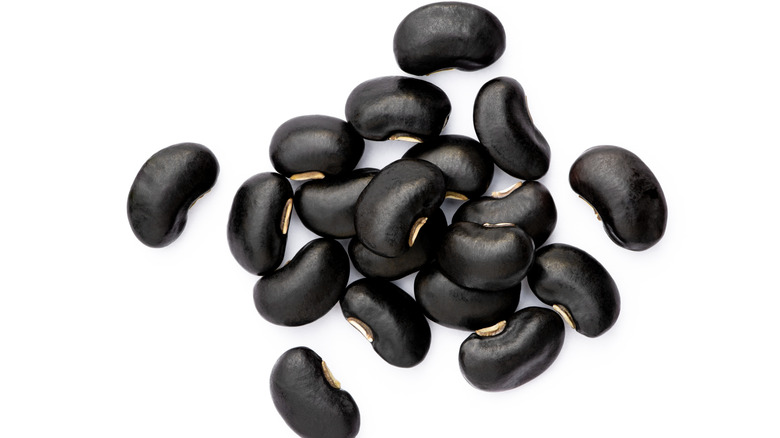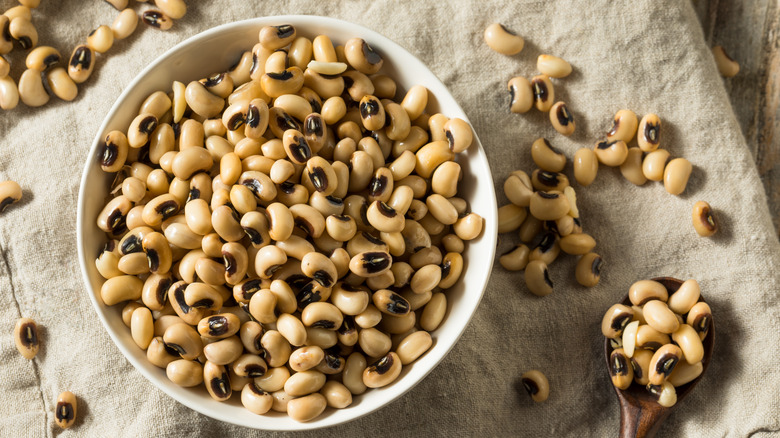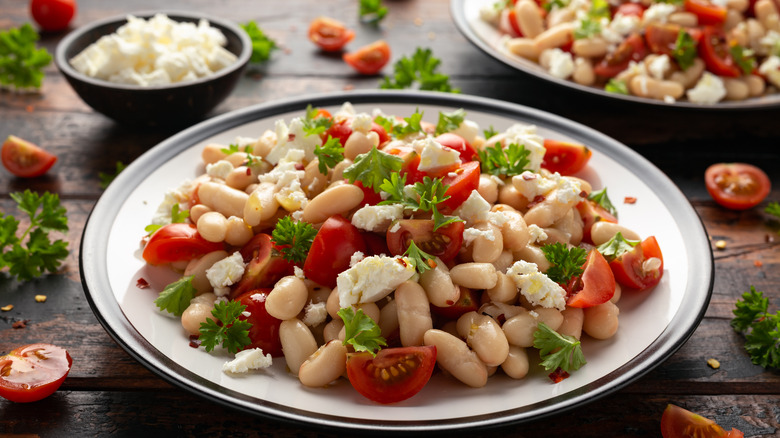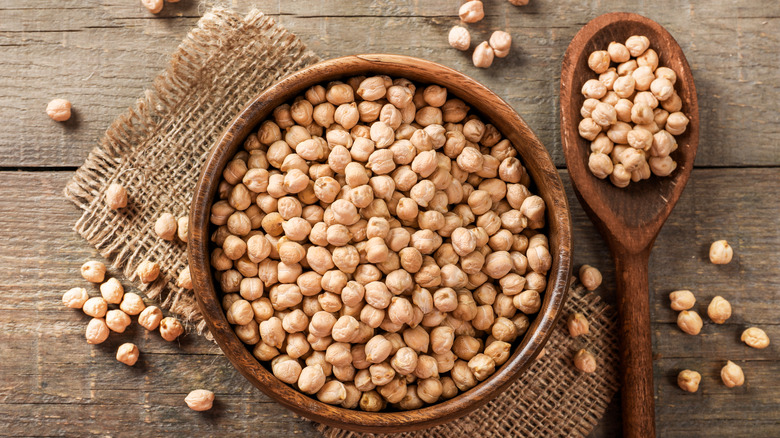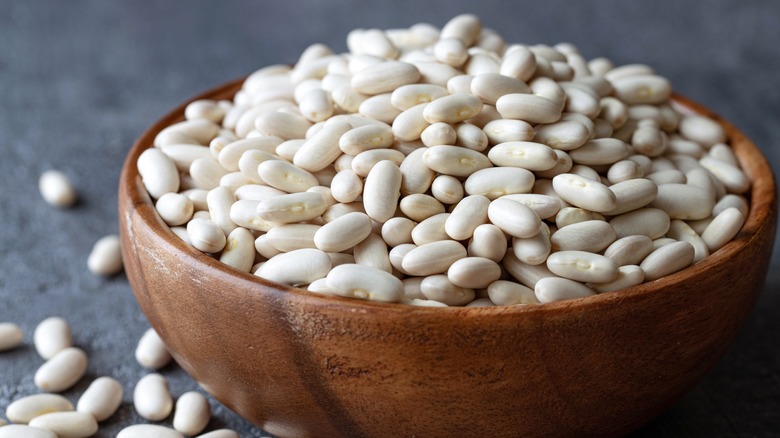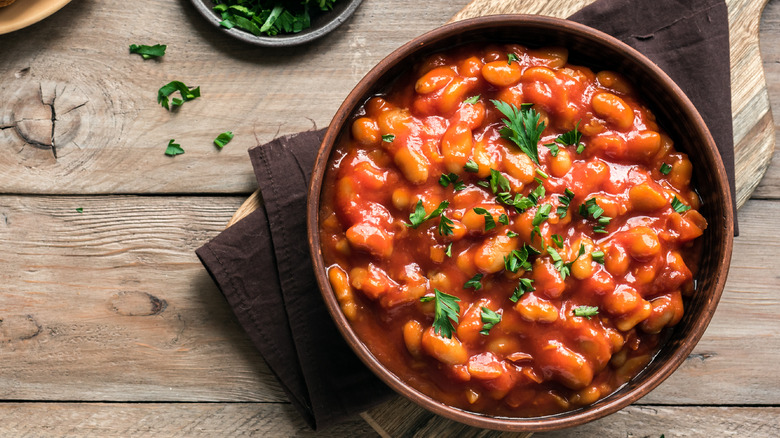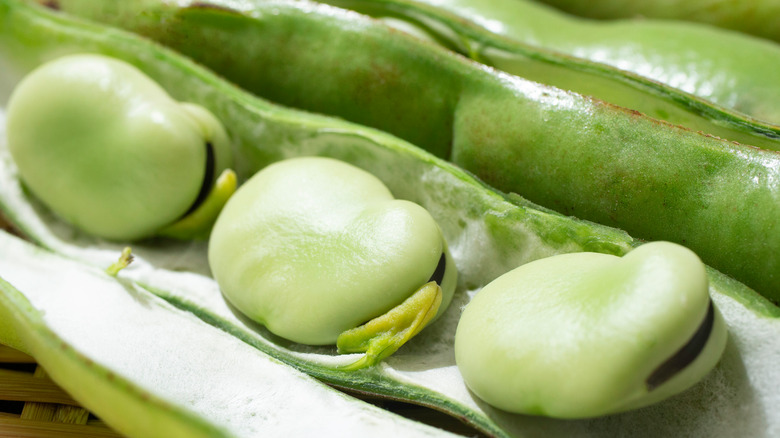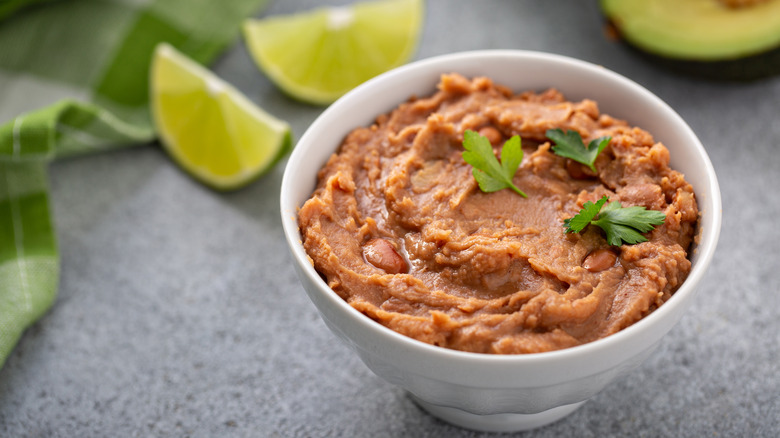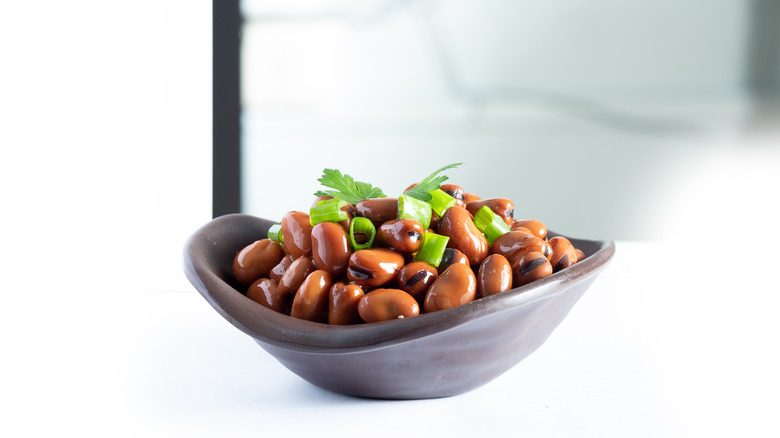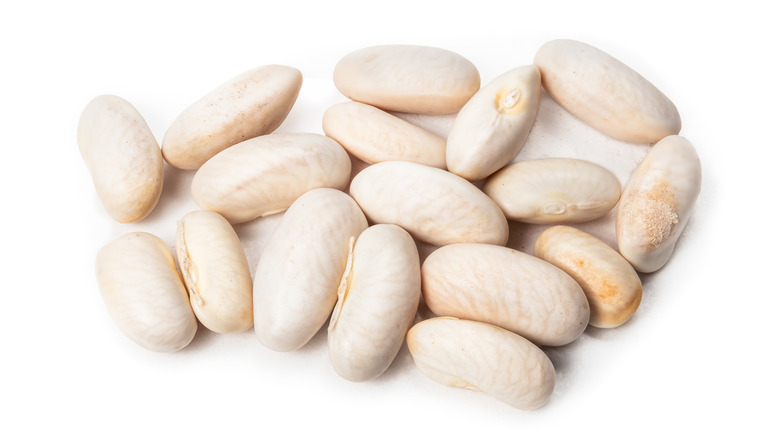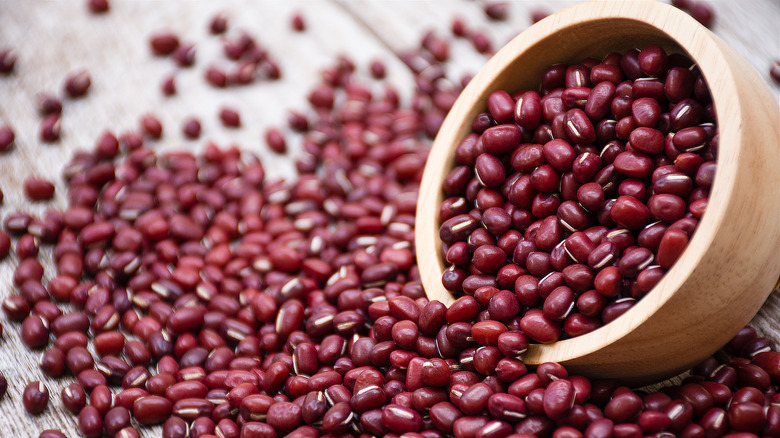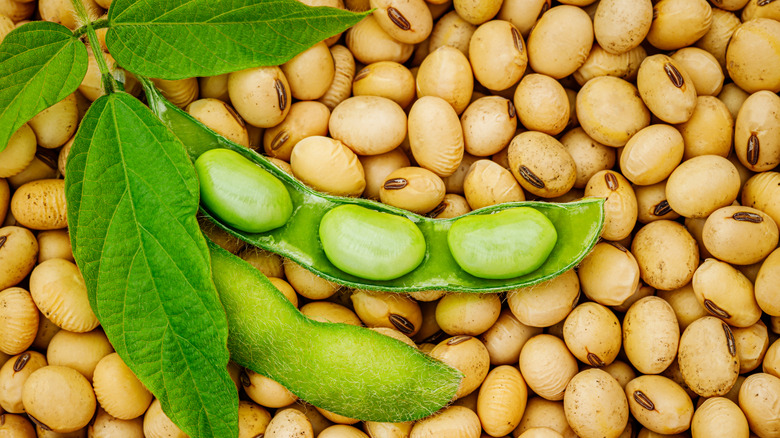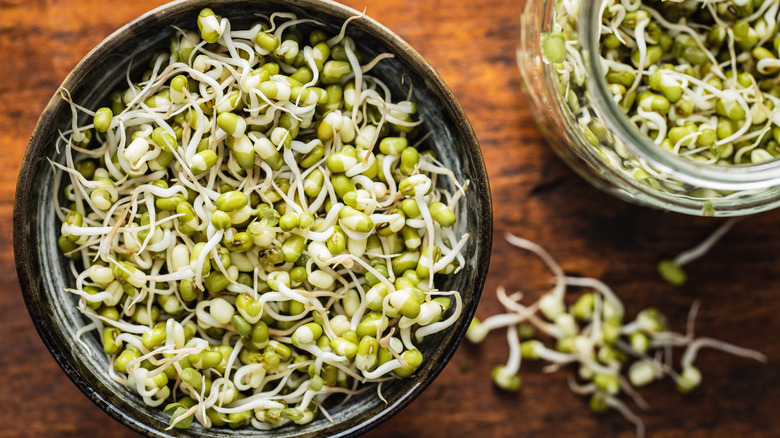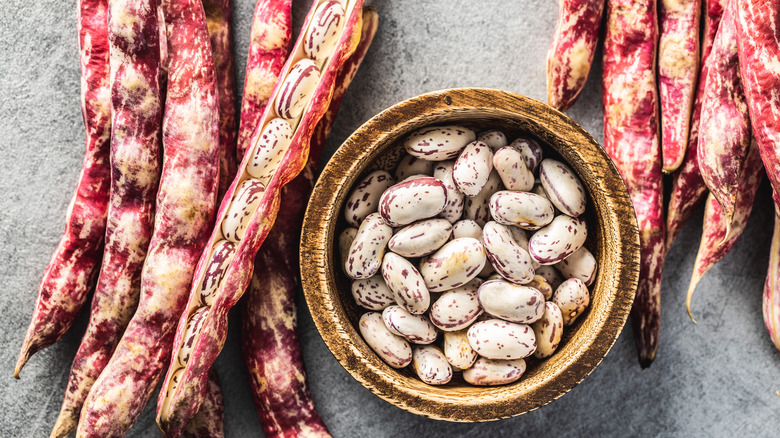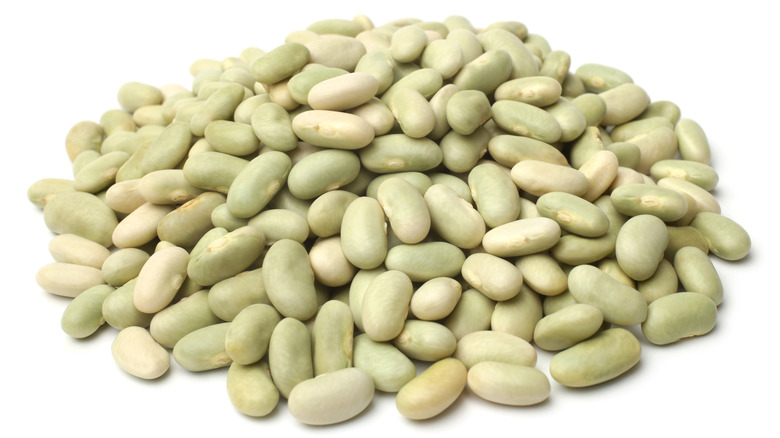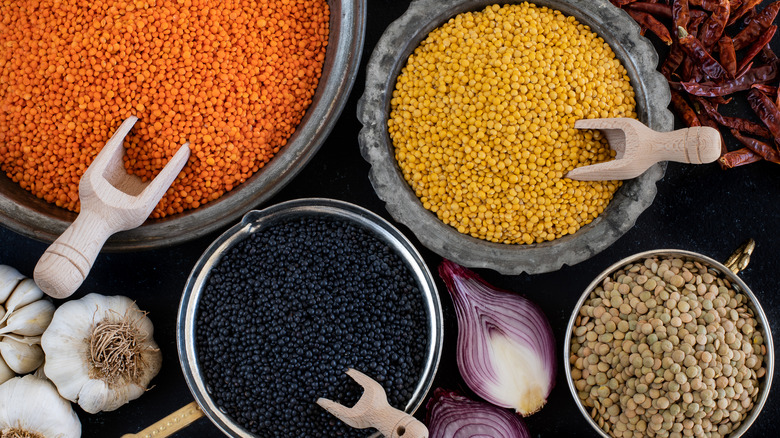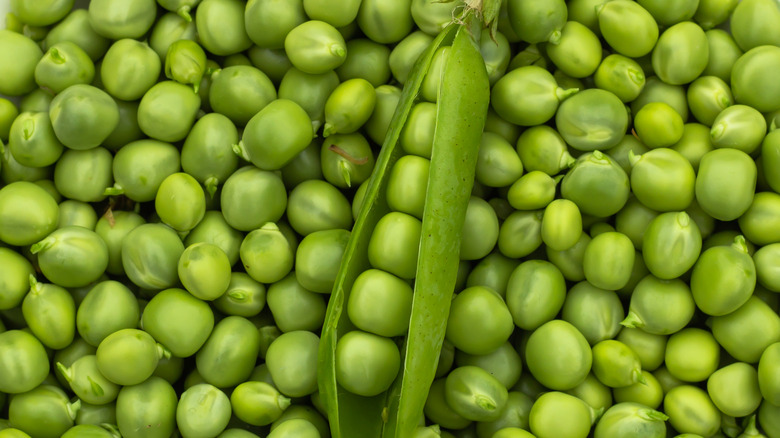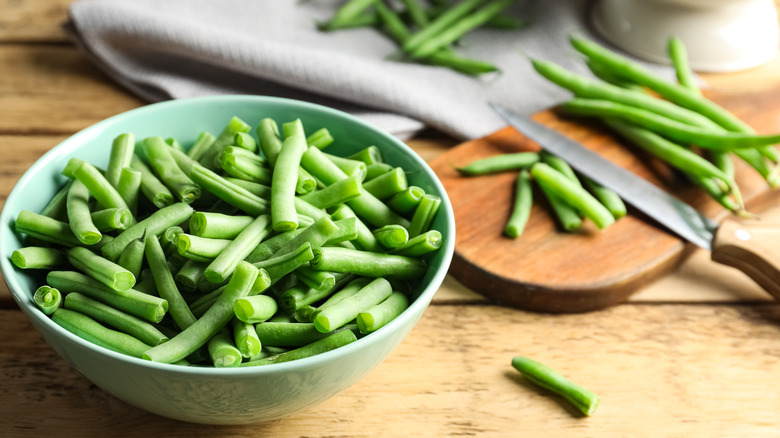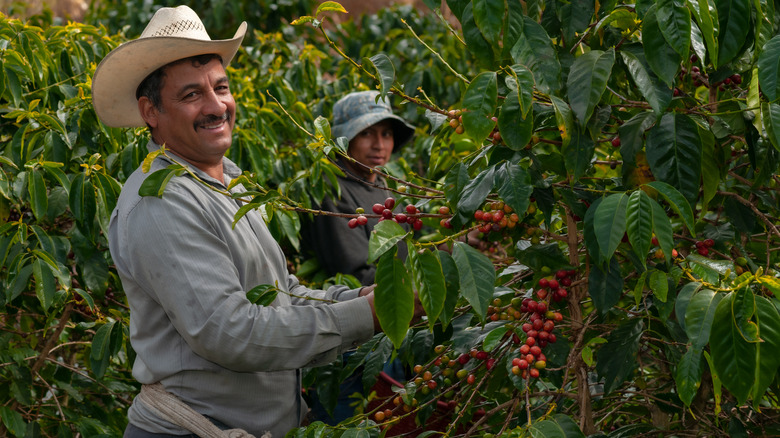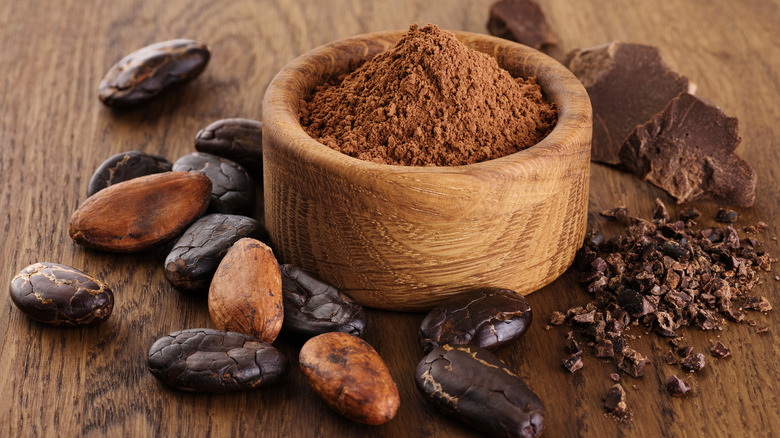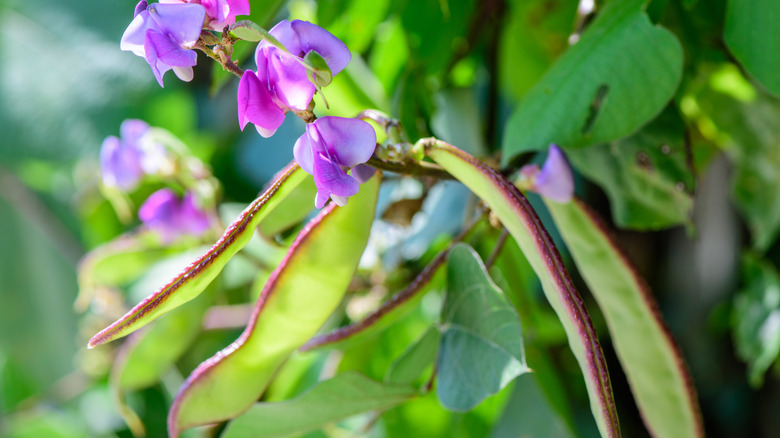Types Of Beans And How To Cook Them
We may receive a commission on purchases made from links.
The origins of beans are varied and can be difficult to pinpoint exactly. Evidence of bean cultivation can be found in parts of Central and South America going back to 7000 B.C. (via FoodReference.com). Many estimate that beans were present in the Middle East approximately 10,000 years ago (via New World Encyclopedia). Broad beans were cultivated in parts of Europe 4,000 years ago (via Vegetable Facts). Beans are also mentioned in sections of the Bible, pointing to their ancient roots.
Legumes, peas, and beans all belong to the Fabaceae or Leguminosae family (via Harvard School of Public Health). Beans are chock full of nutrients and are packed with protein and fiber, making them an excellent addition to any diet, particularly a plant-based diet (via Bean Institute). These nutritional powerhouses can be stored for years.
Beans are endlessly adaptable. They can be eaten whole or used to make dishes, such as sleek and mujadra. They can be mashed and used in dips and pastes. Beans are present in different meals — from breakfasts to vegan menus — and cuisines. They can even be used to make brownies.
Whether you're trying to figure out what to do with some old beans in your pantry or just trying to incorporate more of these nutrient-rich foods into your diet, the world of beans is varied and complex. There are several different types of beans, and each kind has its own uses, characteristics, and profile.
Black bean
Black beans, also known as turtle peas, have been around for more than 7,000 years. They have long been a staple food in Central and South America.
They are medium-sized, are shaped like an oblong pea, and covered in a dark black skin from which they derive their name. Black beans are incredibly beneficial to the diet; they contain vitamins and minerals that help build strong bones and may help reduce blood pressure, in addition to having a whole host of other health benefits (via Medical News Today).
Black beans have a smooth texture and slightly sweet flavor. This makes them ideal for a number of cooking styles. They can be served alongside eggs in a breakfast dish or made into soup. They can be served whole in a salad or smashed into a dip. Additionally, their unique blend of sweetness and dark color make them an excellent flour substitute in gluten-free brownies.
Given this versatility, it's no wonder that black beans have become one of the top five most popular beans in the United States (via AgHires). Additionally, despite their growing conditions being limited to warm climates or summer months, black beans are a shelf-stable food (via MasterClass).
Dried black beans can last up to a year and soaked beans can be canned or frozen for similar amounts of time.
Black-eyed pea
Despite their name, black-eyed peas are neither black nor peas (via Library of Congress). Black-eyed peas are a type of cowpea and are classified as a legume. They have been grown since prehistoric times in places such as China and India. Some think they originated in Africa.
These beans are an important part of Southern cuisine in the United States. They were eaten by slaves as early as 1674 and became a staple after the Civil War. Black-eyed peas have thick skin and a "meaty" texture, meaning that unlike more subtly flavored peas or beans, black-eyed peas can stand up to other intensely flavored foods and long cooking times. Black-eyed peas hold their own when cooked; they maintain their flavor profile without dissolving into mush. For this reason, they can be integrated into soups, dishes with smoked meats, as well as classic dishes such as Hoppin' John.
Black-eyed peas remain a popular dish around the world. In Southern parts of the U.S., eating black-eyed peas with collards on New Year's Day is thought to symbolize luck. As with other beans, they are incredibly shelf-stable; they last up to two to three years if stored in an airtight container.
Cannellini bean
Cannellini beans are consumed in different parts of the world (via Dr. Axe). The bean most likely originated in South America, possibly in Peru or Argentina. After being brought into Europe in the 15th century, they became an integral part of the diet in European countries. Today, they are most commonly grown in Italy. Italy is the largest producer and exporter of cannellini beans worldwide.
Cannellini beans are about half an inch long and shaped like a kidney bean: For this reason, they are sometimes also known as white kidney beans. They have a creamy texture and a nutty flavor, making them a good choice for herbed dishes, stews, and soups (via Camellia Brand).
Cannellini beans are used in popular Italian soup dishes, such as pasta e fagioli and minestrone. They can also be used to riff off other classic dishes such as white bean hummus. They have a shelf life of three to five years. Like most dried beans, in addition to being cooked and mashed, cannellini beans can also be sprouted (via MasterClass).
Garbanzo bean
Garbanzo beans or chickpeas have been cultivated in the Middle East for thousands of years (via Healthline). Chickpeas were being grown in Turkey more than 10,000 years ago (via Delishably). They are mentioned in Turkish texts around 3500 B.C.E. as well as in French writing as early as 6790 B.C.E. (via Harvard School of Public Health). Garbanzo beans are small, not quite round beans and range from beige to green, black, brown, and red in color.
They are incredibly high in protein and make an excellent addition to a vegan or vegetarian diet. They are chock full of nutrients and fiber and are delicious. Hummus is perhaps the most popular garbanzo bean dish. In order for hummus to obtain a silky smooth texture, the outer layer must be peeled before being pulverized (via Lifehacker). The skin is so thin, that when soaked and cooked, it becomes loose and can be peeled away from the rest of the bean. Thankfully, there are a plethora of other dishes based on garbanzo beans that don't require this extra work including soups or stews, falafel, or roasted snacks.
Garbanzo beans, like other beans, need to be cooked in water to soften before being used. But wait! Don't throw that cooking water away! The water that chickpeas are cooked in is known as aquafaba and contains essential chickpea protein, making it an excellent egg substitute. Garbanzo beans can last years, but once cooked or opened, they should be used in three to four days (via StillTasty).
Great Northern bean
Northern beans or great northern white beans were originally cultivated by South American indigenous farmers (via Verywell Fit). Spanish explorers who visited the South American continent helped spread this bean across Europe and Africa (via Camellia Brand). These beans have really taken root in North American cooking. Due to their ability to tolerate cold and fluctuating temperatures, they are grown in various locations across the American Midwest (via Delighted Cooking).
Great northern white beans are slightly smaller than cannellini beans (though larger than a navy bean) and have a nutty taste. Their size and delicate flavor make them incredibly useful. As famous canned bean company Bush's Beans points out, they really do live up to their "great" name.
These beans are commonly used in soups and casseroles. They are often used to make baked beans, a staple dish of the American cookout, and the traditional English breakfast. They also form the base for vegan alfredo sauce alternatives. Northern beans do well with long cooking times and freezing, making them perfect for freezer-friendly meals. When dried, canned, and preserved, these beans have a shelf life of two to three years.
Kidney bean
Kidney beans get their name from their slightly bent, rounded shape and deep red coloring, both of which resemble a kidney (via ScienceDirect). The color of the kidney bean can vary from a soft white to the deep red color commonly found in grocery stores (via BBC Good Food). They might also be a deep black color.
Kidney beans are native to Central America and Mexico but have spread across the world and become an important source of protein (via Healthline). According to Bush's Beans, they have a slightly sweet taste and a firm texture. This makes them good for beans and rice, as well as chili or any dish that requires a hearty bean that can hold up to cooking.
When using kidney beans, it's important to ensure that they are cooked properly. Undercooked or raw kidney beans can be toxic and harmful to both people and animals. Boiling the beans for at least 10 minutes after soaking them overnight neutralizes the toxic protein in them, and makes them safe for consumption. Dry or canned, kidney beans will keep when stored in a cool, dry place, but once soaked, these beans should be used within a few days.
Lima bean
Lima beans have been cultivated in Peru for 9,000 years (via U.S. Department of Agriculture). By the 1300s, Lima Beans had reached North America. The bean is named after Peru's capital city of Lima. Lima beans are also called "Madagascar beans" or "Rangoon beans." Americans sometimes call them butter beans. The Lima bean plant's proper name is "lunatus," which means half-moon.
The beans themselves are small and pale in color and have a slightly rounded shape, which is how they got the name "half-moon." They have a creamy consistency, which makes them perfect for dishes like succotash, a mixed vegetable side dish.
David Shannon's book "A Bad Case of Stripes" features lima beans as being the cure for the fictional disease of stripes. And while the disease does not exist, lima beans do have health benefits. They are full of protein, fiber, and vitamins, and have been known to promote heart health and stabilize blood sugars (via Healthline).
Raw Lima beans are toxic, so they must be soaked and cooked to reduce any poisonous properties. A long overnight soak may also help neutralize any adverse digestive effects. Once cooked, lima beans should be frozen or refrigerated (via StillTasty).
Pinto beans
Pinto beans are the most popular bean in the United States (via Healthline). They appear on the menus of popular restaurants such as Chipotle and Qdoba. According to the Crop Science Society of America, they are also the most commonly grown bean in the United States.
Pinto beans are widely used in Mexican cuisine. Like Lima beans, they have been grown in Mexico and Peru for over 5,000 years. Dry pinto beans are beige with a speckled brown pattern on them but turn solid brown when cooked. Like some other bean varieties, they have a mildly nutty or earthy flavor and can be eaten whole or mashed.
Pinto beans can be used to make soups, added to burritos for protein and fiber, mashed into dips, or cooked on their own to make a yummy slow cooker side dish. Most recipes for refried beans incorporate pinto beans (via Serious Eats). Pinto beans aren't just delicious, they are also incredibly nutritious, providing iron, magnesium, and phosphorus. They are also rich in fiber and antioxidants. Frozen pinto beans last for up to six months in the freezer (via Diys.com).
Broad bean
The broad bean or the fava is one of the oldest known cultivated plants in the world. These beans have been grown and consumed by the Greeks, the Romans, and in the Mediterranean since 6000 B.C. Since then, they have spread across the globe and has become popular in Asian, European, and African cooking, though they have been slow to take off in the United States.
These small, bright green beans are an early spring crop and can be grown at home. They may require up to an 80-day growing season. They can be purchased at Middle Eastern and Greek markets, though they are more expensive than the average bean.
Fava beans are one of the few beans that can be eaten raw when fresh. Raw favas can be used in salads or eaten on their own. In most cases, these beans will need to have the pods removed. There is a thin, clear skin on the outside of the bean that is typically removed before consumption.
Broad beans can also be eaten cooked in dishes, fried, or mashed into dips or recipes such as fava bean falafel. Broad beans can also be dried, like many other beans, and stored for long periods of time. They can be soaked and cooked to be reconstituted, which makes the beans tender again.
Navy bean
Navy beans are in the same family as pinto and black beans: Phaseolus vulgaris, also known as common beans (via The World's Healthiest Foods). They are all descendants of a shared ancestor bean in Peru. Despite the "navy" in its name, these beans are small, about the size of a pea, and have a creamy white color. Their current name refers to the fact that they were regularly consumed by the United States Navy in the 20th century. They are also referred to as haricot beans.
Though these beans are small, they are fierce. They are thought to provide a host of health benefits including reducing heart disease and helping stabilize blood sugar. They also contain nutrients such as iron and magnesium. Their smooth but dense texture and mild flavor helped make this bean a staple, not just in the Navy but in homes too. They can enhance any dish from salads to soups.
Navy beans grow well in the United States, and can typically be purchased dried or canned. Dried beans stored in a cool dry place can last for up to a year. To use dried navy beans, they should be soaked and then cooked until tender.
Adzuki beans
Adzuki beans are versatile and delicious. They are cultivated in East Asia and are used in sweet and savory recipes (via Healthline). Though they are available in a variety of colors, the most recognized adzuki bean is a small, oval-shaped, red bean.
They are used in many different ways. In China and Japan, it is common to cook the beans in water and sugar, mash them, and turn the mash into a sweet red bean paste. This paste is used as a filling for savory dishes, as well as sweet dishes, giving them a red filling or hue. In China, foods made with adzuki beans are thought to bring good luck and prosperity for the new year.
Adzuki beans can also be ground into flour or used whole in soups and other dishes. Unlike many other beans, adzuki beans don't need to be soaked before being cooked. This makes them an easy alternative to other beans if you don't have the time for a presoak.
Adzuki beans have a long 120-day growing period and don't grow well in many climates (via Gardening Know How). But while they might be difficult to acquire or grow, their versatility and incredible nutritional benefits make them well worth the effort. They should be stored dried in a cool dry place for more than a year (via Utah State University).
Soy bean
Today, soy has become a popular additive and substitute in various foods (via United Soybean Board). Soybean derivatives, such as oil, soy protein, and soy lecithin are often added to processed foods. All of these products come from the same source, the soybean.
According to some theorists, soybean was cultivated in China in 7000 B.C. and has since been used as a premier ingredient in many Asian cuisines (via Britannica). Since it was introduced to the United States in 1804, soy has become one of the world's most economically important crops. In the United States alone, in 2016, 83.4 million acres of land are dedicated to growing soybeans (via SoyStats 2017).
In the United States, most kinds of soy have been genetically modified to enable resistance to herbicide, which enables them to grow better in the climate and to ward off pests. The soybean bean is small and can range in color from yellow to white, brown, and can even be multicolored (via Medical News Today). The bean can be eaten steamed in the shell as a dish called edamame (via Medical News Today).
Soybeans can also be processed into sauces, such as soy sauce and miso paste, and turned into concentrated soy protein, such as tempeh and tofu. Soybeans can be bought in cans or dried in packets (via Leslie Beck). Edamame can be purchased fresh and frozen.
Mung bean
According to WH Perron, the mung bean "is the most consumed bean in the world." Mung beans have been cultivated in India since ancient times (via Alternative Field Crops Manual). Today, the mung bean is grown across Asia, Australia, and South America. Mung beans in the United States can be traced back to 1835. Today, nearly all American production of mung beans is based in Oklahoma.
Mung beans are small and green. They turn white when sprouted, and grow long shoots. The flavor is mild but can turn bitter with age. Mung beans are typically used in one of two ways: either cooked and used in dals or soups, or sprouted and used on or in various dishes such as stir-fries, soups, and egg rolls.
Mung beans can be bought dry in many Asian markets in the United States. And you can either sprout them yourself at home by placing them in water that you change twice a day, or you can purchase pre-sprouted mung beans in the grocery store. Either way, if you find yourself with extra sprouts that aren't going to be used immediately, place them in a container with a sealed lid and refrigerate.
Cranberry bean
Cranberry beans are also known as roman, borlotti, or Saluggia beans (via Verywell Fit). They belong to the legume family and are related to the pinto bean (via Woodland Foods). The two share similarities, including high fiber content, easy accessibility, and relative affordability which help to make them a popular bean choice.
The cranberry bean has a medium oval shape and is either white or tan speckled with red. These beans are smooth and firm and their taste has been described as being similar to a chestnut. They can be found year-round in most grocery stores either canned or dried. Fresh cranberries may be found at the end of summer in a farmer's market (via MasterClass).
The beans are generally soaked and boiled till tender. They are popular in Italy and are used for dishes such as pasta e fagioli (literally pasta and beans), and in Portugal for recipes such as feijoada (a traditional bean stew). Fresh beans will last three to four days when kept in the refrigerator and dried beans can be stored for one year (via James Beard Foundation).
Flageolet bean
Flageolet is a French bean, pronounced, as "fla-zho-LAY," and known as the "caviar of beans" (via Woodland Foods). They are small, kidney-shaped beans with a delicate flavor. They are picked just before ripeness, shelled, and dried in the shade to avoid losing their beautiful green coloring.
Dried flageolet beans should be rinsed and soaked for six to eight hours and cooked in water, ensuring that they simmer but do not boil (via FineCooking).
Flageolet beans are typically used in recipes that pair with their delicate flavor. The French cook them in traditional mirepoix stock with bacon. But flageolets can also be mashed into a dip, made into various soups, or served alongside poultry, lamb, and in salads.
While flageolets are found in the United States, they tend to be more expensive. As with many other beans, flageolets can be dried and stored for more than a year, although, after six months they may require extra cooking to soften. They can also be frozen once cooked.
Lentils
Lentils are the oldest cultivated legume in the world (via 2016 International Year of Pulses). Proof of lentil cultivation dates back to 8000 B.C. in Syria (via NPR). They have long been used in Indian and Middle Eastern cooking to make everyday foods and comforting meals.
Lentils are small legumes. There is no need to soak them before cooking. And they come in a variety of colors and types, each of which has its own specific uses. After soybeans, they have the highest content of protein per bean. This makes them a hearty and filling food for anyone staying away from meat. Not only are they good for people, but they are good for the environment. Planting lentils helps promote nitrogen creating bacteria in the soil. And they produce very few greenhouse gasses compared to other crops (via MindBodyGreen).
From dals to mujadara, meat substitutes, and soup, lentils can be used for many different dishes and they are fairly easy to store. Kept in a cool, sealed container, dried lentils can last for up to a year (via Unlock Food).
Peas
Many of us know peas as they appeared on our dinner tables, straight from a can and sitting in their own juice. But there is so much more to peas than that. The origin of peas is shrouded in mystery (via Britannica). We know it is one of our oldest cultivated crops. Evidence of its existence has been found in the Middle East and dates back to the Neolithic period. European colonizers brought peas to various other regions throughout the world. They are used in cooking throughout Europe and Asia.
There are different types of peas, each of which has its uses. Varieties such as sugar snap are delicious and edible right off the vine (via University of Illinois Extension). They are tender and have plump seeds inside, allowing them to be truly good enough to eat raw. By contrast, varieties that contain smooth seeds are better used in soups and other traditional bean-based dishes such as stews.
Peas are a spring/summer crop. Once picked, they can last in the fridge for up to a week (via MasterClass). Like other beans though, peas can be preserved in a number of ways. They can be dried, such as the smooth-seed variety above, or they can be canned. You can also freeze them.
Green bean
As with many other beans, green beans can be traced back to Peru and were spread to parts of South and North America by indigenous people (via U.S. Department of Agriculture). Green Beans were brought back to Europe by Columbus; the first European botanical drawing of green beans was made by a German doctor in 1542 (via Gardening Know How).
Despite their name, green beans aren't only green (via Simply Recipes). Green bean just refers to long, tender beans that can be cooked fresh and eaten. They come in many colors, including purple, yellow, and speckled. Green beans or string beans, as they are often called, were not always as popular as they are today. For a long time, they were considered an ornamental crop, and not until more selective breeding was done to get rid of some of the stringiness did green beans become a more popular choice. But even then, due to their short harvest season, it wasn't until the invention of freezers that the consumption of green beans increased.
Green beans are delicious steamed, sautéed, sliced, and added to soups or in any number of dishes. Green beans can commonly be found at farmers' markets seasonally. Fresh, canned, and frozen beans can be purchased at the grocery store. They can last for a week in the fridge or can be frozen or canned (via StillTasty).
Coffee bean
Coffee is a wonderful plant that gives us one of the world's most popular beverages, namely, coffee. Sometimes, it can be hard to remember that this magical beverage comes from beans.
The origins of coffee are uncertain, with legends tracing it back to Ethiopia and the Arabian Peninsula (via National Coffee Association). We do know that by the 15th century, the coffee trade was expanding, and by the 17th century, coffee was becoming popular across the European continent. Despite coffee's popularity, it takes a lot to get these beans ready to drink.
The coffee bean is found inside the fruit of the coffee tree, called a coffee cherry (via National Coffee Association). To get to the seed on the inside (the coffee bean) the outer layers of the coffee cherry must be stripped away to reveal (most likely) two coffee beans (via Britannica). Once the beans are dried and cleaned, the coffee is considered "green coffee," which is then sorted, cleaned, and dried.
To store whole bean or ground coffee, keep beans and grounds in an airtight container to keep coffee fresh. Grounds will go stale faster than the beans; try and consume the former within a couple of weeks and the latter within a month of roasting. Ground coffee can be stored in the freezer, but this can affect the final quality of the coffee.
Cocoa bean
Cocoa beans are another example of a bean that gives us something an incredibly popular product, namely, chocolate. The cocoa tree is from South America, where ancient civilizations, such as the Aztecs, have been making cocoa-based foods and drinks for several thousand years (via World Cocoa Foundation). When the Spanish first came to South America, they found the plant and added their own ingredients, such as sugars and spices, creating the sweet chocolate that has become popular today.
Cultivating cocoa isn't easy (via Cocoa Life). The plant is sensitive and requires very specific conditions, such as high heat and rainfall. Properly cared for, the tree produces its fruit, or cocoa pods, each containing about 30 to 40 cocoa beans. To make chocolate, the beans are removed from the pod and fermented with their pulp for days before drying in the sun. The beans are then ground into a smooth paste and sugar is mixed in to form chocolate.
Cocoa beans can be turned into two popular products: Cocoa powder and cocoa butter (via European Cocoa Association). Store cocoa powder in a cool airtight container, and avoid placing it in the refrigerator as the added humidity can cause it to spoil. Cocoa powder should last two years in a cool, dry container. Chocolate bars, on the other hand, should be well wrapped and stored away from heat. While they can be stored in the fridge, it's not recommended (via Martha Stewart).
Hyacinth bean
Hyacinth beans come from a delicate and stunning flowering plant that produces edible fruit pods (via Monticello). The Hyacinth plant is native to tropical parts of Africa. It was also known as the Egyptian or Indian bean and had become a part of the European gardening scene by the early 1700s.
Hyacinth beans are planted in spring or the early days of summer (via Growing In The Garden). The beans themselves are typically purple but can also be purple around the edges with a green center, and when cooked, turn fully green. These beans can be cooked in a variety of ways but should be cooked when they are young and still soft. They can be boiled, sauteed, or roasted but they must be consumed fully cooked (via Eat the Weeds). Uncooked hyacinth beans are toxic and require longer cook times than other beans to ensure that their toxic properties have been fully neutralized.
If you find yourself with dried hyacinth beans, you have to not only soak them but also boil them twice. And unlike chickpeas, their cooking water should always be discarded and never used for anything else. They can be used in stir fry and curry or sprouted. Beans that have been shelled and dried can be stored in a cool dry place for two years (via Vidyascooking). Sprouted beans can be frozen for up to six months.
